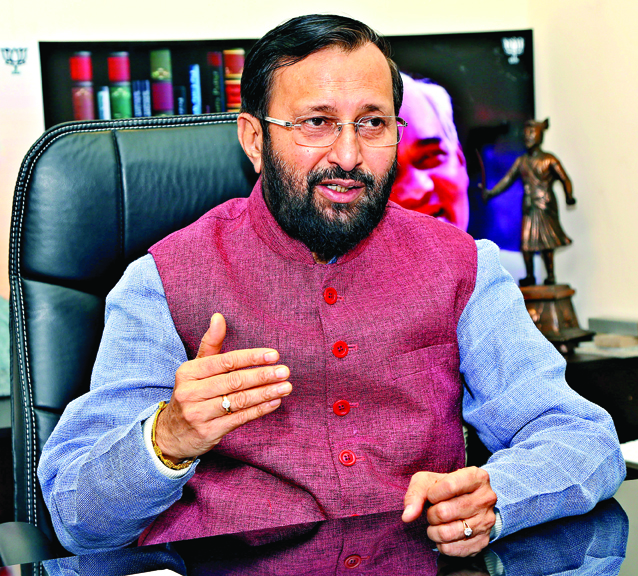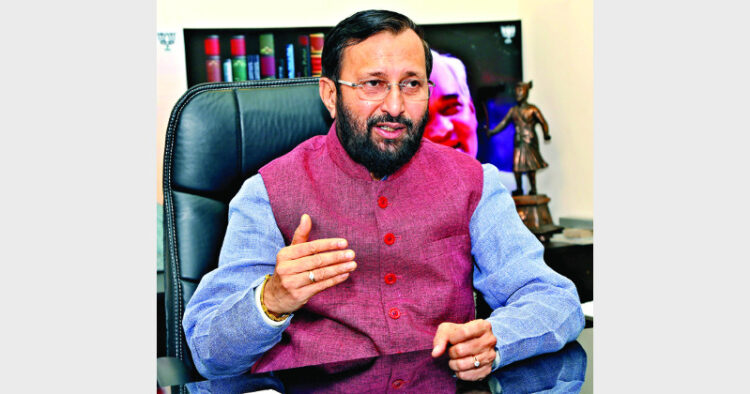The debates and deliberations on the reforms in education and what must be done for the same tend to somehow get glued to the Higher Education alone. However, any serious attempt to harness the benefits of ‘demographic dividend’ has to start acting with larger emphasis on the Primary and Secondary education. When Union Human Resource Development Minister Prakash Javadekar interacted with the representatives of Organiser Nishant Kr Azad and Shaan Kashyap, he talked about his efforts and vision to transform the face of education in the country
Your Ministry took up this largest ever sample survey called the National Achievement Survey to evaluate the performance of Class III, V and VIII students. However, the findings in the survey reflect a sorry state of affairs under the Right to Education (RTE). What is your reaction?
We have published the country wide profile, state-wise profile and district-wise profile. We have prepared what I call district-wise kundali which is the report on school education and it has been sent to the respective Members of Parliament (MPs). The reflection of a dismal performance under the survey is the result of practically non-teaching under the Right to Education in the ten-years of the United Progressive Alliance (UPA) Government. Now year after year, one will find improvement gradually because we have fixed accountabilities, learning outcomes are back in the focus, examinations will be conducted regularly, and we are sure that results will improve.
Online portals like Shagun show an active participation of the Central Government in the Sarva Shiksha Abhiyan. Why can the Central Government not take the lead in school education as it has done in cleanliness drive?
No, actually the Central Government is taking a lead in the course correction regarding education. We had almost four meetings in previous years with all the stake holders including the State Governments. Everyone is taking an active interest in education because this realisation has come to us that if education collapses, the nation collapses. Online platforms like Diksha are working effectively, where teachers are recording their own lectures and circulating it all over. We have also engaged all the NGOs working in the field of value education, physical education, digital education, life skill education and all the possible areas are being covered. With all the officials, NGOs, Principals and teachers, we all sat together through six chintan shivirs to come out with new innovations and possibly better practices than before. See, subjects like education cannot get reformed by just pushing a switch. It takes time and a collective effort.
The mantra is to ‘Go Global, Search Global’ and then bring back good NRI faculties and also motivate our own researchers to take up jobs in academics
What is the status on National Education Policy?
National Education Policy is in its last leg. The final draft is getting ready. By next fortnight it should be ready and a copy will also be sent to the Prime Minister. Then, the due procedure has to be followed from discussing it in the Cabinet to tabling it in the Parliament. It is going to be a policy for the next two decades and therefore, we are not in a hurry. This is a decision which requires a lot of deliberation and all the stake holders have to be taken on board.
The various changes in the NCERT textbooks are being debated. Is it a reform or a routine exercise of updating the textbooks?
This is not reform but updating. While updating the textbooks we invite the suggestions from the concerned teachers, and based on those suggestions, changes are incorporated. Look, we have not formed committees to re-write the textbooks. The experts and scholars from NCERT made the necessary changes. Our rich legacy should reflect in our textbooks.
Everyone is taking an active interest in education because this realisation has come to us that if education collapses, the nation collapses
Your Ministry fulfilled its one of key BJP manifesto promises in educational reforms by going ahead to grant the autonomy to Higher Education institutions. Why was it significant?
The world experience is that unless you give the real freedom and allow the universities to excel in their own way, education sector cannot perform to the best under Government’s interference. Therefore, we granted complete autonomy to the Indian Institutes of Management (IIMs) and others. The bill was unanimously passed. We will be implementing it from July. The rules have also been formulated. Firstly, we will focus on the IIMs, and then Institutions of Eminence, where a committee of experts will select 20 institutions that will be granted complete autonomy and extra funds will be provided as well. Secondly, we have granted autonomy based on quality benchmark considering the NAAC accreditation. Seventy universities which include Central, State, Private and Deemed Universities have been granted autonomy. Now, they will not have to come to the regulators for every academic initiative. This is the best kind of autonomy which a Government can offer.
The faculty crunch is a big trouble now. Data suggest that almost 35-40 per cent of the faculty positions are lying vacant. What are you doing to address this issue?
Right from the IITs to NITs, IIMs, and Central Universities there is a genuine faculty crunch. Since I have been involved in that agitation in the past, I know about it. I started impressing upon the respective Vice-Chancellors to act fast in this direction. The mantra is to ‘Go Global, Search Global’ and then bring back good NRI faculties and also motivate our own researchers to take up jobs in academics. We were successful in making this faculty recruitment a big drive in all the universities. Meanwhile, the Hon Allahabad High Court judgment considering stated that SC/ ST/ OBC quota should be implemented not seeing university as one unit, but department as one unit. It was opposed by all the concerned groups because their quota was getting lesser. Since we are with their cause, we have filed a special petition in the Court. We could not progress in the last six months because of this hurdle. I am sure that in the next 2-3 years the 40 per cent vacancies will come down to 10 per cent.
In the last four years, the NDA Government has opened up 7 new IIMS, 6 new IITs and 2 new IISERS. Doesn’t this tendency of adding up new institutions seem like a persistence of the same Nehruvian Socialist mindset where you go on adding new institutions and don’t improve the old ones?
When you have the Gross Enrolment Ratio of 25 per cent, you need to improve the number. And for that we have started to expand the units all over. We are taking one more step in 150 Aspirational Districts by opening at least one new model Degree College and upgradation of two existing colleges. We are funding them liberally. Secondly, besides this expansion, we have passed distance education and online education regulations. We are getting new areas of expansion now! SWAYAM, a scheme which we launched some ten months back has now expanded with more than a thousand courses and 22 lakh users which include students, teachers, different professionals and senior citizens. All are taking a number of courses. This is a new revolution!














Comments